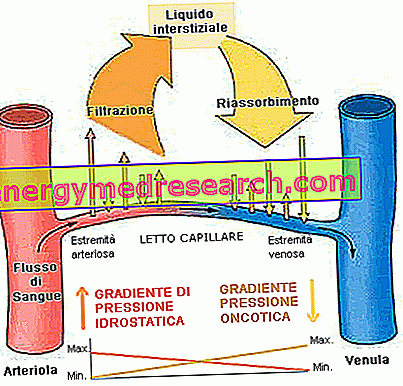Without any offense against the other anatomical structures involved, we can say that the entire cardiovascular system exists with the sole purpose of serving the capillaries. It is at this level, in fact, that the aforementioned exchanges of nutrients, hormones, antibodies, gases and all that is transmitted by the haematic current take place. The cells, on the other hand, depend strictly on the ability of the capillaries to supply all the elements necessary for their metabolism, while at the same time removing the waste that would poison them. But what rule this passage?
Exchanges of substances from capillaries to cells can be essentially of three types.
A) The first is represented by the diffusion . Typical of gases, it reflects the net movement of molecules from the point of greatest concentration to that at a lower concentration; this flow continues until the molecules are uniformly distributed in every part of the available space. The majority of the exchanges between plasma and interstitial fluid occurs by simple diffusion, which involves substances such as ions, low-PM molecules, amino acids, glucose, metabolites, gases, etc .; however they do not filter molecules with a molecular weight of more than 60kD, such as large proteins and corpuscles of blood (white, red blood cells, etc.). In particular, the fat-soluble substances pass through the plasma membranes and the exchange is limited by the speed of the blood flow; the water-soluble ones, on the other hand, pass through small pores and their flow is regulated by the width of these pores and by the radius of the molecule considered.
The mechanism of diffusion becomes less efficient in the presence of edema, because the high quantity of interstitial fluid increases the distance between the tissues and the capillary.
B) A second type of exchange is given by the filtration-reabsorption system, which - also known as mass flow - mainly regulates the passage of fluids. If the flow direction is oriented towards the outside of the capillaries we speak of filtration, while when it is directed towards the interior we speak of absorption.
The regulation of this flow depends on three factors: the hydraulic or hydrostatic pressure, the oncotic or colloid-osmotic pressure and the permeability of the capillary wall.
- A few lines ago we recalled that the hydrostatic pressure at the arterial end of the capillary is around 35 mm Hg, while that at the venous end is about half. These values reflect the lateral pressure exerted by the blood flow, which tends to push the liquid out through the walls of the capillary itself. On the contrary, the hydrostatic pressure exerted by the interstitial liquid (estimated at 2 mm Hg), favors the opposite path, pressing against the walls of the capillary and favoring the entry of liquids inside it.
- The second factor, the oncotic pressure, is strictly dependent on the concentration of proteins in the two compartments. These, in fact, have a very similar composition, except for plasma proteins, which are almost absent in the interstitial fluid. The oncotic pressure represents the force that regulates the passage of water by simple diffusion from the "proteically" less concentrated to the more concentrated compartment, through a semipermeable membrane interposed between them (which allows water to pass through it but not from the proteins present in it) and given, in this case, by the capillary walls.
The oncotic pressure exerted by the proteins present in the blood is equal to 26 mm Hg, while in the interstitial fluid it is almost negligible.

- The third and last factor is represented by the hydraulic conductance, which expresses the water permeability of the capillary wall. This size varies according to the morphological characteristics of the capillaries (for example, it is greater in the fenestrated ones, typical of the kidney).
These three elements are articulated in Starling's law:
capillary exchanges depend on a constant hydraulic conductance multiplied by the difference between the hydrostatic pressure gradient and the colloidosmotic pressure gradient.
LAW OF STARLING Jv = Kf [(Pc - Pi) - σ (ppc-ppi)]
At the arterial end of the capillary we would have a net filtration pressure of:
| [(35 - (- 2)] - (25-0) = 12 mm Hg | this pressure causes the release of liquids and metabolites present in the blood (filtration occurs) |
Along the passage in the capillaries speed and hydraulic pressure are reduced due to friction. Oncotic pressures tend to remain the same, except when the capillary walls are quite permeable to low molecular weight proteins. This characteristic has important repercussions, since it reduces the capillary oncotic pressure, increasing the interstitial one. To take this possibility into account, Laplace's law was corrected by inserting the so-called reflection coefficient (σ), so that: Jv = Kf [(Pc - Pi) - σ (ppc-ppi)].
The reflection coefficient varies from 0 (capillary wall completely permeable to proteins) to 1 (capillary wall impermeable to proteins).
At the venous end of the capillary we would have a net filtration pressure of:
| [(15 - (- 2)] - (25-0) = -8 mm Hg | this pressure causes the entry of liquids and cellular metabolites into the blood (reabsorption occurs). |
NOTE: the lower reabsorption pressure is compensated by the greater permeability of the capillary to the venous head; despite this, the filtered volume is still greater than the one reabsorbed. In fact, only 90% of the filtered volume at the arterial end is reabsorbed to the venous one; the remaining 10% (about 2 l / d) is recovered by the lymphatic system, which prevents the formation of edema by pouring it into the bloodstream.
The pressure values shown in the examples are indicative and are not rare exceptions. The capillaries that make up the glomeruli of renal nephrons, for example, tend to filter along their entire length, while some capillaries present at the level of the intestinal mucosa only absorb, collecting nutrients and liquids.
C) The third mechanism is called transcytosis and is responsible for the transport of some molecules of high molecular weight, such as certain proteins which, after being incorporated into vesicles by endocytosis, pass through the epithelium and are released into the interstitial fluid by exocytosis.



